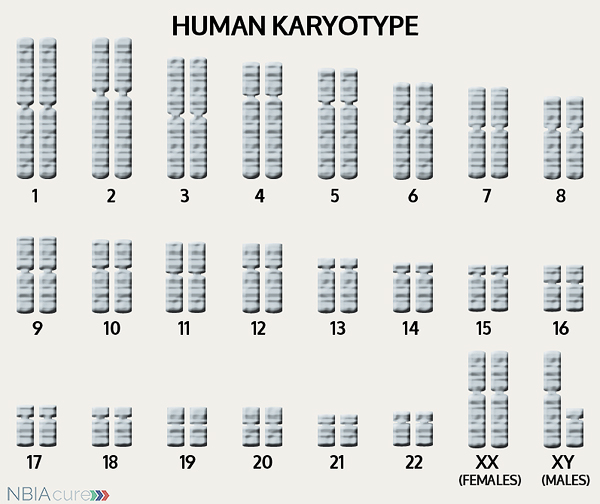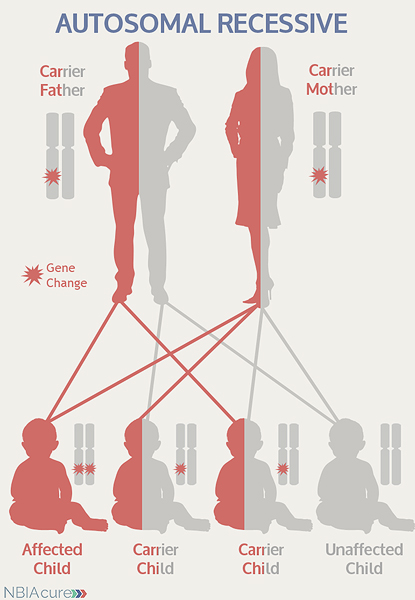If you or a loved one has recently been diagnosed with FAHN, we hope our website can help answer some of your questions and guide you to the most appropriate resources. We encourage you to call our team to speak to a genetic counselor who can help you navigate this diagnosis. Please email us at info@nbiacure.org and we will set up a phone call with you.
FAHN (Fatty Acid Hydroxylase-associated Neurodegeneration) is a rare NBIA disorder that involves muscle spasticity and dystonia, eye findings early in the disease, and progressive intellectual impairment and seizures later in the disease course.
Two other neurologic conditions, leukodystrophy and hereditary spastic paraplegia 35 (HSP35), were previously thought of as separate disorders, but are now included in the spectrum of FAHN.
SYMPTOMS
Symptoms of FAHN usually start to appear during childhood or the teenage years. The symptoms of FAHN are mostly confined to the central nervous system (the brain and spine).
Common symptoms include:
Corticospinal tract involvement (communication pathway between brain and limbs)
- Spastic paraplegia or quadriplegia (progressive lower limb spasticity and weakness)
- Pyramidal tract signs (motor pathway between brain and spine)
- Hyperreflexia (overactive reflexes)
- Clonus (involuntary, rapid, alternating muscle contraction and relaxation)
- Babinski sign (Plantar reflex)
- When the sole of the foot is rubbed with a blunt object, the big toe flexes upwards abnormally
Movement disorder(s)
- Dystonia (involuntarily muscle contraction and spasms)
- Milder than in other NBIA disorders
- Ataxia (coordination problems)
Dysarthria (poor articulation or slurring of speech)
- Progressive speech problems can make it difficult to be understood by acquaintances and others in the community. Usually people close to the individuals with FAHN have learned to better understand their speech.
- Expressive speech may be impaired to the point of anarthria (loss of speech)
Dysphagia (difficulty swallowing)
Eye findings
- Optic atrophy (deterioration of the nerve that connects the eye to the brain)
- Strabismus (crossed eyes)
- Both eyes are not properly aligned and point in different directions
- Lateral-beating nystagmus (involuntary eye movement in the lateral direction)
- Supranuclear gaze palsy (inability to look in a particular direction because of brain impairment)
Seizures
- May occur later in disease
Progressive intellectual impairment
CAUSE/GENETICS
 The human body is made up of millions of cells. Inside every cell there is a structure called DNA, which is like an instruction book. DNA contains detailed steps about how all the parts of the body are put together and how they work. However, DNA contains too much information to fit into a single “book”so it is packaged into multiple volumes called chromosomes. Humans typically have 46 total chromosomes that are organized in 23 pairs. There are two copies of each chromosome because we receive one set of 23 chromosomes from our biological mother and the other set of 23 from our biological father. Chromosomes 1-22 are called autosomes and the last pair is called the sex chromosomes because they determine a person’s gender. Females have two X chromosomes and males have one X and one Y.
The human body is made up of millions of cells. Inside every cell there is a structure called DNA, which is like an instruction book. DNA contains detailed steps about how all the parts of the body are put together and how they work. However, DNA contains too much information to fit into a single “book”so it is packaged into multiple volumes called chromosomes. Humans typically have 46 total chromosomes that are organized in 23 pairs. There are two copies of each chromosome because we receive one set of 23 chromosomes from our biological mother and the other set of 23 from our biological father. Chromosomes 1-22 are called autosomes and the last pair is called the sex chromosomes because they determine a person’s gender. Females have two X chromosomes and males have one X and one Y.
If DNA is the body’s instruction book and it is stored in multiple volumes (called chromosomes), then genes would be the individual chapters of those books. Genes are small pieces of DNA that regulate certain parts or functions of the body. Sometimes multiple genes (or chapters) are needed to control one function. Other times, just one gene (or chapter) can influence multiple functions. Since there are two copies of each chromosome, there are also two copies of each gene. In some gene pairs, both copies need to be expressed (or turned on) in order for them to do their job correctly. For other genes pairs, only one copy needs to be expressed.
When a single cell in the human body divides and replicates, its DNA is also replicated. This replication process is usually very accurate but sometimes the body can make a mistake and create a “typo” (or mutation). Just like a typo in a book, a mutation in the DNA can be unnoticeable, harmless, or serious. A mutation with serious consequences can result in a part of the body not developing correctly or a particular function not working properly.
In the case of NBIA disorders, changes in certain genes cause a person to develop their particular type of NBIA. Changes in these NBIA genes lead to the groups of symptoms we observe, although we do not yet understand how the changed genes cause many of these findings. FA2H is the only gene known to cause FAHN. FA2H’s main job is to tell the body’s cells how to make an enzyme called fatty acid 2-hydroxylase, which modifies fatty acids. When a change in the FA2H gene impairs the function of this enzyme, the result in abnormal myelin. Myelin is a protective layer of fatty acids that insulates nerves and helps with the rapid transmission of nerve signals. A change in the FA2H gene results in weak myelin that is prone to deterioration and leads to the development of the movement problems and other neurological abnormalities seen in FAHN. It is not yet clear to us how a change in the FA2H gene eventually leads to iron accumulation in the brain.
As mentioned earlier, humans have a total of 23 pairs of chromosomes. Half of these chromosomes are passed down (or inherited) from the biological mother and half from the biological father. The way in which a gene carrying a change is passed down from parents to child varies from gene to gene. The FA2H gene that is altered in those with FAHN is inherited in an autosomal recessive manner.
“Autosomal” refers to the fact that the FA2H gene is located on chromosome 16,which is one of the autosomes (chromosome pairs 1-22). Since the sex chromosomes are not involved, males and females are equally likely to inherit the changed gene. “Recessive” refers to the fact that a gene change must be present in both copies of the FA2H gene for a person to have FAHN. If an individual has only one FA2H gene change, then they are called a “carrier” for FAHN. Carriers do not have health problems related to that gene change and often do not know they carry a recessive gene change. However, if two FAHN carriers have a child together, then there is a 25% chance that they will both pass on their recessive FA2H gene changes and have a child with FAHN.
 As seen in the image to the left, in a pregnancy between two FAHN carriers:
As seen in the image to the left, in a pregnancy between two FAHN carriers:
- There is a 25% chance of the child having FAHN
- There is a 50% chance that the child will be a carrier like his/her parents
- There is a 25% chance that the child will not have FAHN or be a carrier
DIAGNOSIS & TESTING
A brain MRI is a standard diagnostic tool for all NBIA disorders. MRI stands for magnetic resonance imaging. An MRI produces a picture of the body that is created using a magnetic field and a computer. The technology used in an MRI is different from that of an x-ray. An MRI is painless and is even considered safe to do during pregnancy. Sometimes an MRI is done of the whole body, but more often, a doctor will order an MRI of one particular part of the body.
Evidence of iron accumulation on a brain MRI is often an important clue leading to the diagnosis of FAHN. A T2 sequence is the preferred type of MRI for NBIA diagnosis because it is highly sensitive to the detection of brain iron.
MRI findings for FAHN include:
- T2 hypointensity (darkness) of the globus pallidus
- T2 subcortical white matter hyperintensity (brightness)
- Progressive atrophy (decrease in mass) of the cerebellar hemispheres, vermis, pons, medulla and spinal cord
- Thinning of the corpus callosum
A bone marrow biopsy may show accumulation of granular histiocytes (immune cells that destroy foreign substances to protect the body from infection)
- Is not needed for diagnosis
Diagnosis of FAHN is confirmed through genetic testing of the FA2H gene to find two gene changes. At least one FA2H gene change is found through DNA sequence analysis in >95% of individuals.
If no gene change or only one gene change is found through sequence analysis of the FA2H gene, then genetic testing may proceed to deletion/duplication analysis.
Rarely, an individual with the signs and symptoms of FAHN will have only one or even no FA2H gene changes identified. This can happen because the genetic testing is not perfect and has certain limitations. It does not mean the person does not have FAHN; it may just mean we do not yet have the technology to find the hidden gene change. In these cases it becomes very important to have doctors experienced with FAHN review the MRI and the person’s symptoms very carefully to be as sure as possible of the diagnosis.
MANAGEMENT
 There is no standard treatment for FAHN. Patients are managed by a team of medical professionals that recommends treatments based on current symptoms.
There is no standard treatment for FAHN. Patients are managed by a team of medical professionals that recommends treatments based on current symptoms.
After diagnosis, individuals with FAHN are recommended to get the following evaluations to determine the extent of their disease:
- Neurologic examination for dystonia, ataxia, and spasticity
- Neurologic evaluation of ambulation (walking), speech, and feeding
- Ophthalmologic assessment for evidence of optic atrophy or eye movement abnormalities
- Developmental assessment
- Assessment for physical therapy, occupational therapy, and/or speech therapy
- Medical genetics consultation
- Consider whether a consultation for nutrition and/or swallowing is appropriate
The most commonly treated FAHN symptom is dystonia (involuntarily muscle contraction and spasms), which can be debilitating and distressing to affected individuals and their caregivers. The therapies for managing dystonia vary in method and success rate.
Therapies to manage dystonia can include:
- Intramuscular botulinum toxin
- Botox is injected in spastic, dystonic muscles to help them relax for a period of time
- Artane (trihexyphenidyl), taken orally, usually divided into multiple doses each day
- Baclofen (oral or intrathecal)
- One of the main drugs used to treat FAHN dystonia, usually first taken orally and divided into several doses each day
- In the intrathecal method, an implanted baclofen pump delivers medication directly into the spinal fluid
- Deep brain stimulation
- Used increasingly more often in NBIA and has some evidence for benefit
- A stimulator sends electrical impulses to the affected brain region to help muscles relax
- It involves surgical implantation of a lead, extension and battery pack (IPG)
- The lead contains 4 electrodes and is implanted in the globus pallidus region of the brain
- The extension connects the lead to the battery pack (IPG)
- The IPG is a battery-powered neurostimulator that is placed in the abdomen (or in some cases below the clavicle)
- Physical and occupational therapy
- May or may not be indicated for those who are only mildly symptomatic
- Therapies to maintain normal joint mobility for as long as possible may be useful
- Speech therapy is often indicated for FAHN-related dysarthria
Weighted gloves can sometimes be used to help with dysmetria (poor coordination of movements)
Long-term management for FAHN can include:
- Nutrition
- Monitoring of height and weight in children
- Swallowing evaluation and regular dietary assessments
- Assure adequate nutrition
- Prevent aspiration
- Gastrostomy tube placement (as needed)
PROGRESSION
FAHN is a progressive disease, but the declines in health occur at irregular intervals. Between declines, there can be periods of relative clinical stability (when the patient’s symptoms do not get worse). However, skills that an individual has lost are usually not regained. As the disease progresses, dystonia and spasticity make it harder for the person to walk and eventually lead to wheelchair use.
Premature death may occur in the 20s or 30s due to a combination of nutrition-related immunodeficiency and respiratory compromise. However, the average life span is variable.
Copyright © 2014 by NBIAcure.org. All rights reserved.